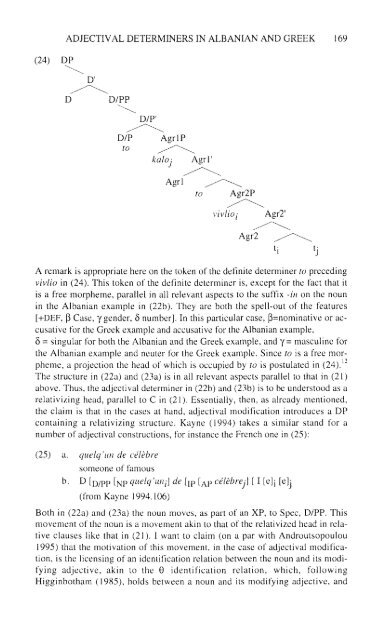- Page 2 and 3:
Comparative Syntax of Balkan Langua
- Page 4 and 5:
Comparative Syntax ofBalkan Languag
- Page 6 and 7:
Contents1 Introduction 3Maria Luisa
- Page 9 and 10:
This page intentionally left blank
- Page 11 and 12:
4 MARIA LU1SA RIVERO AND ANGELA RAL
- Page 13 and 14:
6 MARIA LUISA RIVERO AND ANGELA RAL
- Page 15 and 16:
8 MARIA LUISA RIVERO AND ANGELA RAL
- Page 17 and 18:
10 MARIA LUIS A RIVERO AND ANGELA R
- Page 19 and 20:
12 MARIA LUISA RIVERO AND ANGELA RA
- Page 21 and 22:
14 MARIA LUISA RIVERO AND ANGELA RA
- Page 23 and 24:
16 MARIA LUISA RIVERO AND ANGELA RA
- Page 25 and 26:
18 BRIAN D. JOSEPHsubjects are perm
- Page 27 and 28:
20 BRIAN D. JOSEPH(1) Pan-Balkan Cl
- Page 29 and 30:
22 BRIAN D. JOSEPHd. Alb perpiqem t
- Page 31 and 32:
24 BRIAN D. JOSEPHIf similarities i
- Page 33 and 34:
26 BRIAN D. JOSEPHdepends on what o
- Page 35 and 36:
28 BRIAN D. JOSEPHe. introducer of
- Page 37 and 38:
30 BRIAN D. JOSEPHi." Mi ta xerja s
- Page 39 and 40:
32 BRIAN D. JOSEPHspecial propertie
- Page 41 and 42:
34 BRIAN D. JOSEPHc. *John did defi
- Page 43 and 44:
36BRIAN D. JOSEPH(14)PositiveNegati
- Page 45 and 46:
38 BRIAN D. JOSEPHthe German term n
- Page 47 and 48:
40 BRIAN D. JOSEPH28. I find Zwicky
- Page 49 and 50:
42 BRIAN D. JOSEPHJoseph, B. D. 199
- Page 51 and 52:
3Head-to-Head Mergein Balkan Subjun
- Page 53 and 54:
46 CARMEN DOBROVIE-SORIN2.1. Contro
- Page 55 and 56:
48 CARMEN DOBROVIE-SORINanaphoric s
- Page 57 and 58:
50 CARMEN DOBROVIE-SORINb. E greu s
- Page 59 and 60:
52 CARMEN DOBROVIE-SORINconfigurati
- Page 61 and 62:
54 CARMEN DOBROVIE-SORIN(19) a. Jua
- Page 63 and 64:
56 CARMEN DOBROVIE-SORINb. Doresc c
- Page 65 and 66:
58 CARMEN DOBROVIE-SORIN(27)In orde
- Page 67 and 68:
60 CARMEN DOBROVIE-SORINb. *Bonibel
- Page 69 and 70:
62 CARMEN DOBROVIE-SORINOne may won
- Page 71 and 72:
64CARMEN DOBROVIE-SORIN(d)Neg has a
- Page 73 and 74:
66 CARMEN DOBROVIE-SORIN(43) a. Ion
- Page 75 and 76:
68 CARMEN DOBROVIE-SORIN(47) A feat
- Page 77 and 78:
70 CARMEN DOBROVIE-SORINand NP rais
- Page 79 and 80:
72 CARMEN DOBROVIE-SORINReferencesA
- Page 81 and 82:
4Control and Raisingin and out of S
- Page 83 and 84:
76 ANNA ROUSSOUb. Voglio an da re.
- Page 85 and 86:
78 ANNA ROUSSOUlatridou (1993) cons
- Page 87 and 88:
80 ANNA ROUSSOUignore the propertie
- Page 89 and 90:
82 ANNA ROUSSOU2.2. Mood and comple
- Page 91 and 92:
84 ANNA ROUSSOU(1992b), namely the
- Page 93 and 94:
86 ANNA ROUSSOUpurposes it suffices
- Page 95 and 96:
88 ANNA ROUSSOUextend to raising pr
- Page 97 and 98:
90 ANNA ROUSSOULet us now go back t
- Page 99 and 100:
92 ANNA ROUSSOU(33) Ta pedja fenond
- Page 101 and 102:
94 ANNA ROUSSOU(37) a. I tried (*fo
- Page 103 and 104:
96 ANNA ROUSSOU(41) O Janis deli (i
- Page 105 and 106:
98 ANNA ROUSSOURoberts (1996) argue
- Page 107 and 108:
100 ANNAROUSSOU7. Sportiche (1997)
- Page 109 and 110:
102ANNAROUSSOUChomsky, N. 1986. Bar
- Page 111 and 112:
104 ANNAROUSSOURoberts, I. 1996. "T
- Page 113 and 114:
106 ILIYANA KRAPOVAterms of binding
- Page 115 and 116:
108 ILIYANA KRAPOVAsubset (as in (4
- Page 117 and 118:
110 ILIYANA KRAPOVAstrictly differe
- Page 119 and 120:
112 ILIYANA KRAPOVA2.3. PRO subject
- Page 121 and 122:
114 ILIYANA KRAPOVAThe fact that co
- Page 123 and 124:
116 ILIYANA KRAPOVAadverb vcera 'ye
- Page 125 and 126: 118 ILIYANA KRAPOVAillustrated in (
- Page 127 and 128: 120 ILIYANA KRAPOVA(34) a. Iskain d
- Page 129 and 130: 122 ILIYANA KRAPOVAmovement of na+V
- Page 131 and 132: 124 ILIYANA KRAPOVA13. It has been
- Page 133 and 134: 126 ILIYANA KRAPOVARivero, M. L. 19
- Page 135 and 136: 128 DALINA KALLULLIprcsuppositional
- Page 137 and 138: 130 DALINA KALLULLImoment, let us j
- Page 139 and 140: 132 DDALINAKALLULLIb. den pijeno me
- Page 141 and 142: 134 DALINA KALLULLId. What did Ana
- Page 143 and 144: 136 DALINA KALLULLIb. O Janis (*ta)
- Page 145 and 146: 138 DALINA KALLULLIHowever, the fac
- Page 147 and 148: 140DALINA KALLULLIb. Anna hat das B
- Page 149 and 150: 142 DALINA KALLULLIWhile definite a
- Page 151 and 152: 144 DALINA KALLULLIWhat are the fac
- Page 153 and 154: 146 DALINA KALLULLIproperties. The
- Page 155 and 156: 148 DALINA KALLULLIobjects, are in
- Page 157 and 158: 150 DALINA KALLULLIIn this section
- Page 159 and 160: 152 DALINA KALLULLI(62) a. weil ich
- Page 161 and 162: 154 DALINA KALLULLI7. Albanian and
- Page 163 and 164: 156 DALINA KALLULLIpresumably respo
- Page 165 and 166: 158 DALINA KALLULLI47. In the Princ
- Page 167 and 168: 160 DALINA KALLULLIRaposo, E. 1997.
- Page 169 and 170: 162 ANTONIA ANDROUTSOPOULOUpreposit
- Page 171 and 172: 164 ANTONIA ANDROUTSOPOULOUd.e.f.va
- Page 173 and 174: 166 ANTONIA ANDROUTSOPOULOU(20) a.
- Page 175: 168 ANTONIA ANDROUTSOPOULOUcal feat
- Page 179 and 180: 172 ANTONIA ANDROUTSOPOULOU(iii)(iv
- Page 181 and 182: 174 ANTONIA ANDROUTSOPOULOUThe Alba
- Page 183 and 184: 176 ANTONIA ANDROUTSOPOULOUOn the o
- Page 185 and 186: 178 ANTONIA ANDROUTSOPOULOU(42) a.b
- Page 187 and 188: 180ANTONIA ANDROUTSOPOULOU(43)(44)I
- Page 189 and 190: 182 ANTONIA ANDROUTSOPOULOUshown in
- Page 191 and 192: 184 ANTONIA ANDROUTSOPOULOU(56) a.b
- Page 193 and 194: 186 ANTONIA ANDROUTSOPOULOUIn (58)
- Page 195 and 196: 188 ANTONIA ANDROUTSOPOULOUto D). D
- Page 197 and 198: 190 ANTONIA ANDROUTSOPOULOU(3)That
- Page 199 and 200: 192 ANTONIA ANDROUTSOPOULOU(11) a.b
- Page 201 and 202: 194 ANTONIA ANDROUTSOPOULOUadjectiv
- Page 203 and 204: 196 ANTONIA ANDROUTSOPOULOU(ii) ena
- Page 205 and 206: 198 ANTONIA ANDROUTSOPOULOU24. It i
- Page 207 and 208: 8Last Resort and V Movementin Balka
- Page 209 and 210: 202 MARIA LUISA RIVEROthey need not
- Page 211 and 212: 204 MARIA LUISA RIVEROterms and is
- Page 213 and 214: 206 MARIA LUISA RIVERO(8) a.b.Kogaw
- Page 215 and 216: 208 MARIA LUISA RIVEROthat the orde
- Page 217 and 218: 210 MARIA LUIS A RIVEROfeature must
- Page 219 and 220: 212 MARIA LUIS A RIVEROThe restrict
- Page 221 and 222: 214 MARIA LUIS A RIVERO3. Greek in
- Page 223 and 224: 216 MARIA LUIS A RIVEROmovement in
- Page 225 and 226: 218 MARIA LUISA RIVEROThe equivalen
- Page 227 and 228:
220 MARIA LUISA RIVERObecause it sh
- Page 229 and 230:
222 MARIA LUISA RIVEROHolmbcrg, A.
- Page 231 and 232:
This page intentionally left blank
- Page 233 and 234:
226 NAME INDEXFarkas, D., 8,54,57,7
- Page 235 and 236:
This page intentionally left blank
- Page 237 and 238:
230 SUBJECT INDEXbare output condit
- Page 239 and 240:
232 SUBJECT INDEXindividual-denotin
- Page 241:
234 SUBJECT INDEXsubjuntive operato
















